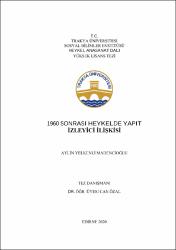1960 sonrası heykelde yapıt izleyici ilişkisi
Özet
Bu tez çalışmasında; heykelin tanımı, uygulama yöntemlerindeki köklü
değişimleri ve bu değişim sürecinde izleyicinin sanat yapıtı ile aktif iletişimi üç
bölümde ele alınmıştır. 1960’lara kadar yapıt karşısında edilgen-salt izleyicikonumda
olan izleyici, 1960’lardan sonra yapıta ‘katılımcı’ olarak dâhil edilmiştir.
Bu önemli değişim, heykeli tanımlamada ve uygulamada yapısal bir dönüşüme de
yol açmıştır.
Modernizm Öncesi Heykel başlığı altındaki tezin ilk bölümünde;
Modernizme kadar olan geleneksel anlamdaki heykelin tarihsel anlatımı ve bu
süreçte izleyicinin konumu irdelenmeye çalışılmıştır.
Modernizm İle Birlikte Sanatta Yapısal Dönüşümler ve Heykele Yansımaları
başlıklı ikinci bölümde; 1900’lerin başından itibaren sosyal, politik, teknolojik,
bilimsel gelişmelerin sanata etkisi ve Dadaizm ile birlikte sanat yapıtına izleyicinin
dâhil olma süreci ele alınmıştır.
1960 Sonrası Heykelin Tanımı, Uygulama Yöntemlerinin Köklü Değişimleri
ve İzleyicinin Sanat Yapıtı İle Aktif İletişimi başlıklı üçüncü bölümde; 1960’lardan
sonra heykel sanatının geçirdiği evrim-süreç ve sanattaki açılımlar tanımlanırken;
öncelikli olarak izleyicinin heykelle kurduğu ilişki ve bu alandaki sanatçıların
çalışmalarıyla ortaya koydukları fikirler, sanat mekânının çeşitlenmesiyle birlikte
incelenmiştir.
Sanat eserini değerlendirmede önemli bir etken olan izleyicinin işlevinin
değişimini araştıran bu çalışma, günümüz sanat ortamının çeşitliliği ve heykel
algısının dönüşümü açısından heykelin yeniden tanımlanmasında aydınlatıcı
olacaktır. This master research is composed of three main sections; definition of the
sculpture, fundamental changes in the process of sculpting, and the active interaction
of the viewer in art during these fundamental changes. Until the 1960’s the role of
the viewer in art was considered uninclusive from the work of art, but right after that
turning point, the viewer became included, started to take part in the work of art.
This important transformation in the viewer’s role has enlarged and influenced the
definition of sculpture and its existential structure.
In the first section, under the title of Sculpture Before Modernism; we
investigate the role of the viewer in art, in the traditional history of sculpture, until
Modernism.
In the second section, under the title of Modernism: Structural Changes in
Art and its Effects in The Domain of Sculpture; we analyze how main socio-politic,
technologic and scientific developments have influenced and shaped the approach
toward to art at the beginning of the 1900’s and how Dadaism has brought the
concept of including the viewer in art, into the concept of experiencing art.
In the third section, under the title of After 60’s: The New Definition of
Sculpture, Fundamental Changes in Sculpting, The Active Interaction of The Viewer
in Art; we reconsider and define the evolution of sculpture and all the new
expansions in the art after the 1960’s. The relationship between the viewer in art and
sculpture, then the new ideas that have been proposed by artists by that time, both
have been researched with the following evolvements in the concept of art space.
This academic research shows one of the main factors regarding the
assessment in art, the role of the viewer in art. Understanding this role’s radical
transformation may help us to reconsider the definition of sculpture and the
perception behind the idea of sculpture, therefore, it provides concordantly a new
perspective to capture today’s diverse art world
Koleksiyonlar
- Tez Koleksiyonu [2146]


















